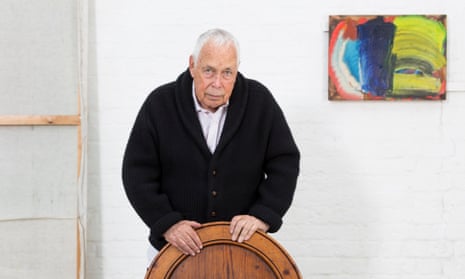Sir Howard Hodgkin, one of Britain’s greatest contemporary artists, known for his explosively coloured paintings of what he once described as “emotional situations”, has died aged 84.
The artist, a central figure in contemporary art for more than 50 years, died peacefully in hospital in London, only a few weeks after returning to the UK from India.
He was known for paintings, always on wood rather than canvas, full of vividly coloured, emotion-packed splodges, swirls, loops and smears. It may not have been obvious to the viewer but the works always had a subject and they were not abstract – he said that he had never painted an abstract picture in his life, that he was a “a figurative painter of emotional situations”.
The director of the Tate galleries, Sir Nicholas Serota, who curated Hodgkin’s first museum exhibition in 1976, led the tributes, calling Hodgkin “one of the great artists and colourists of his generation”.
He added: “His sensuous, intense paintings were infused with his love and understanding of late 19th-century French painting, especially Degas, Vuillard and Bonnard, and by his feeling for the heat and colours of India, which he visited on many occasions.
“Over the past 30 years Howard’s international standing has continued to grow with major exhibitions in Europe and America. His characteristic subject, the memory of a meeting or a conversation with a friend, resulted in paintings that radiate the emotions of life: love, anger, vanity, beauty and companionship.”

Hodgkin, although he had been increasingly frail, had been busy working up until his death with two important exhibitions due to open in 2017.
One is later this month at the National Portrait Gallery (NPG), where the curator Paul Moorhouse was told the news of his death 3o minutes before they began hanging the works on Thursday. “You can’t imagine how that was.” he said. “It is a personal loss and it is a great loss to the art world.”
Moorhouse recalled Hodgkin’s enthusiasm for what is the first exhibition devoted to his portraits – his first reaction was “at last!”.
“He is one of those truly distinctive artists who redefined the way you look at the world. He also changed how artists represent their experiences … He understood that we don’t just interact with the world visually, we interact in terms of emotions and memory and he brought those into the language of painting.”
Moorhouse said Hodgkin was the opposite of an abstract artist. “He never painted a picture which did not have a subject, he couldn’t paint a picture if it wasn’t about something. It was the language he used, this complex language of visual experience, emotion and memory which, yes, was unfamiliar … People have to get on his wavelength and when you do you realise how rich it is.
“We want the exhibition to be a celebration of his achievements. If any artist was about life, Howard was. His paintings are a celebration of life.”
The NPG’s director, Nicholas Cullinan, said Hodgkin was one of our greatest artists. “Howard’s painting has always resisted classification and easy explanation. His work often appears entirely abstract, yet over the course of 65 years a principle concern of his art has been to evoke a human presence, making a significant contribution to our understanding of what a portrait can be.”
The other Hodgkin show opens at the Hepworth Wakefield in June, exploring the influence of India on Hodgkin’s work.
The gallery’s director, Simon Wallis, said they were devastated because the gallery was looking forward to Hodgkin being there and seeing the show.
“He had been incredibly generous and the last six works in the show are the last six paintings he had made in India.”
Wallis said Hodgkin was “one of the most important artists of our time ... His love of colour and gesture and the relationship to the spirit of place and the spirit of people that he was associated with just seemed to radiate from the paintings.”
Hodgkin was born in London in 1932 and evacuated during the second world war to the US where, fortunately for a precocious child who had decided he was to be an artist, he was repeatedly taken to the Museum of Modern Art. Back in the UK he studied at Camberwell School of Art, followed by the Bath Academy of Art in Corsham, Wiltshire.
He was part of a generation of artists who came to prominence in the late 1950s and early 60s, including David Hockney, Peter Blake and Patrick Caulfield, but success came far later to Hodgkin.
When he appeared on Desert Island Discs in 1994 he said the road to recognition in the UK had been hard as it was “enemy territory” for painters.

An important breakthrough was the Serota-curated retrospective at the Museum of Modern Art in Oxford in 1976. Wider fame arrived after he represented Britain at the 1984 Venice Biennale and in 1985 he became the second artist to win the Turner prize.
His importance as a global artist was reflected in the major retrospectives held at the Metropolitan Museum in New York (1995), the Scottish National Gallery of Modern Art (2002), Tate Britain (2006), the Irish Museum of Modern Art (2006) and the Reina Sofia in Madrid (2007).
He was knighted in 1992, something he said he did not really want “but they don’t give things like that to artists”, and made a Companion of Honour in 2002.
Hodgkin was openly gay although he had earlier married Julia Lane in 1955 and had two sons, Louis and Sam.
